This is the fourth entry in the series “Independent Study in World Cinema,” in which this self-educated film nerd attempts to fill in some fairly serious gaps in his self-education. This week, I take a look at one of the most visually influential films of all time, Fritz Lang's seminal 1927 science-fiction classic Metropolis.
This post will be a little shorter and considerably less thorough than previous entries in this series, for a couple of reasons. The first reason is practical: I'm running a little behind this week, and need to make up some ground if I want this to remain a weekly series, and not a bi-weekly, or monthly, or whenever-the-hell-I-get-around-to-it series.
The second reason is less practical, and more a matter of preference: I kind of think Metropolis is a terrible movie.

Directed by Fritz Lang; screenplay by Theo von Harbou; photographed by Karl Freund; production design by Otto Hunte, Erich Kettelhut, and Karl Vollbrecht; with Alfred Abel, Brigitte Helm, Gustav Frohlich, and Rudolf Klein-Rogge. DVD copyright 2012 by Kino International Corp.
Don't get me wrong: there's no question that Metropolis deserves its place in the film-history books, and for that reason alone I'm glad I finally watched it. Fritz Lang's vision of the future contains more arresting images than just about any film before or since, and there is barely a science-fiction film or TV show from the past 86 years that doesn't owe it a debt. Frankenstein, 2001: A Space Odyssey, Doctor Who, Alphaville, Soylent Green, Star Wars, Blade Runner, The Terminator, Brazil, The Fifth Element, The Matrix, Minority Report…I could easily fill this post simply by tracing elements of these works (and many more) back to their roots in Metropolis. Even outside the science-fiction genre, the unmistakable influence of Metropolis can be seen in works as varied as Chaplin's Modern Times, Kubrick's Dr. Strangelove, and any number of films noir, from The Big Sleep to Miller's Crossing.
(This is to say nothing of what an inspiration it's been to rock stars and music videos, from Queen to Madonna to Beyoncé and Lady Gaga.)
But none of that changes the fact that its extraordinarily imaginative aesthetic is really all Metropolis has going for it. "I am a visual person," Lang once said. "I experience with my eyes and never, or only rarely, with my ears—to my constant regret.” And frankly, Lang's exclusively visual approach to his work shows: Metropolis is an endless feast for the eyes, but its acting is weak, its screenplay is clumsy and incomprehensible, and its themes are all either painfully naive, hopelessly muddled, or deeply troubling—and often all three at once. For decades, some of the more baffling elements of the story were blamed on the fact that no complete copy of Lang's original cut of the film existed. However—as we shall discuss below—we now have as close to a full version of Metropolis as we are likely to get, and the restoration of deleted scenes does little to clarify the more confusing and contradictory elements of the film's story: if anything, these scenes often make it messier.
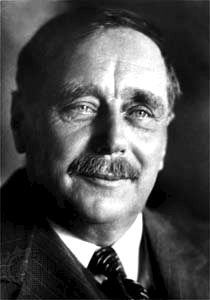 For what it's worth, I'm hardly the first harsh critic of the film. Following its New York premiere in 1927, the New York Times published a review of Metropolis by a gentleman who—while not a professional film critic—could be considered something of an authority on science-fiction: H. G. Wells. "I have recently seen the silliest film," Wells's review begins. "I do not believe it would be possible to make one sillier…It gives in one eddying concentration almost every possible foolishness, cliché, platitude, and muddlement about mechanical progress and progress in general served up with a sauce of sentimentality that is all its own."
For what it's worth, I'm hardly the first harsh critic of the film. Following its New York premiere in 1927, the New York Times published a review of Metropolis by a gentleman who—while not a professional film critic—could be considered something of an authority on science-fiction: H. G. Wells. "I have recently seen the silliest film," Wells's review begins. "I do not believe it would be possible to make one sillier…It gives in one eddying concentration almost every possible foolishness, cliché, platitude, and muddlement about mechanical progress and progress in general served up with a sauce of sentimentality that is all its own."
The German critic Siegfried Kracauer also found the themes of Metropolis muddled and troubling. In his book From Caligari to Hitler: A Psychological History of the German Film (1947), he writes that Metropolis's screenwriter (and Lang's then wife), Thea von Harbou, was "sensitive to all undercurrents of her time, but indiscriminately passed on whatever happened to haunt her imagination." He found Metropolis, therefore, "rich in subterranean content that, like contraband, had crossed the borders of consciousness without being questioned." (This is more or less my view of the film as well: that it has a lot of important, even prescient ideas, but throws them together in a way that is haphazard at best and irresponsible at worst.)
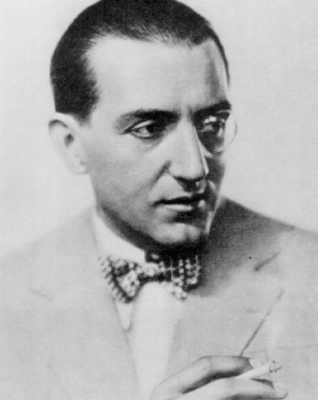 Finally, I should mention the verdict of the filmmaker himself, Fritz Lang. In an interview with director Peter Bogdanovich for the latter's book Who the Devil Made It: Conversations with Legendary Film Directors, Lang calls Metropolis "patched together," and says, "I didn't like it much because it was a picture in which human beings were nothing but part of a machine." He admits he "detested" the movie, calling it "silly and stupid."
Finally, I should mention the verdict of the filmmaker himself, Fritz Lang. In an interview with director Peter Bogdanovich for the latter's book Who the Devil Made It: Conversations with Legendary Film Directors, Lang calls Metropolis "patched together," and says, "I didn't like it much because it was a picture in which human beings were nothing but part of a machine." He admits he "detested" the movie, calling it "silly and stupid."
History, of course, has generally been kinder to Metropolis than I, or these critics, or Lang himself have been, but even its celebrants have tended to note the film's discrepancies and warts. Roger Ebert, writing in 1998, said the plot of the film "defies common sense, but its very discontinuity is a strength. It makes Metropolis hallucinatory—a nightmare without the reassurance of a steadying story line." The great critic Pauline Kael calls Metropolis "a spectacular example of Expressionist design…with moments of almost incredible beauty and power…absurd ineptitudes…and oddities that defy analysis." It is, she concludes, "a wonderful, stupefying folly."
Perhaps the best view of the film—or at least the best advice on how to watch it—comes from one of Lang's contemporaries, the Spanish filmmaker Luis Buñuel:
"Metropolis is not one film; Metropolis is two films joined by the belly, but with divergent, indeed extremely antagonistic, spiritual needs. Those who consider the cinema as a discreet teller of tales will suffer a profound disillusion with Metropolis. What it tells us is trivial, pretentious, pedantic, hackneyed romanticism. But if we put before the story the plastic-photogenic basis of the film, then Metropolis will come up to any standards, will overwhelm us as the most marvelous picture book imaginable."
from Great Film Directors, edited by Leo Braudy. Morris Dickstein, 1978
quoted at CeltoSlavica’s page on Metropolis
I confess that I am first and foremost an appreciator of tales, and so I experienced with Metropolis exactly the sort of profound disillusionment of which Buñuel speaks.
But it sure is a pretty picture book.
Background
Shot over 310 days between May 1925 and August 1926—with unprecedented production design and a cast that included 36,000 extras—Metropolis was one of the most expensive motion pictures ever produced in the silent era. Germany's government-owned film studio, Ufa—already suffering from increased competition from Hollywood and the worsening inflation at home—decided to gamble on Fritz Lang's ambitious vision, hoping it would provide them with a blockbuster that could appeal to U.S. distributors and reassert their dominance over the international film industry.
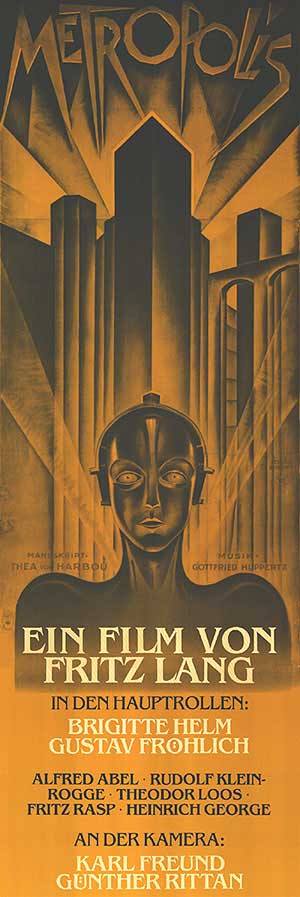 As film historian Bruce Bennett explains, the gamble didn't exactly pay off: by the time the film premiered in Berlin, in January 1927, Metropolis had gone more than 300 percent over budget, had nearly bankrupted Ufa, and had cost legendary producer Erich Pommer his job. The version Lang premiered in Berlin was 153 minutes long, but Paramount Pictures—Ufa's distribution partner in the states—demanded extensive cuts to the film before its scheduled U.S. premiere; they hired American playwright Channing Pollock to oversee a more concise, more coherent version of Metropolis. (Pollock judged the original version of Metropolis "symbolism run such riot that people who saw it couldn't tell what the picture was about.") Pollock rewrote the film's titles, and re-edited Lang's fourteen reels of film down to seven.
As film historian Bruce Bennett explains, the gamble didn't exactly pay off: by the time the film premiered in Berlin, in January 1927, Metropolis had gone more than 300 percent over budget, had nearly bankrupted Ufa, and had cost legendary producer Erich Pommer his job. The version Lang premiered in Berlin was 153 minutes long, but Paramount Pictures—Ufa's distribution partner in the states—demanded extensive cuts to the film before its scheduled U.S. premiere; they hired American playwright Channing Pollock to oversee a more concise, more coherent version of Metropolis. (Pollock judged the original version of Metropolis "symbolism run such riot that people who saw it couldn't tell what the picture was about.") Pollock rewrote the film's titles, and re-edited Lang's fourteen reels of film down to seven.
And so—as was the case with our earlier films Nosferatu and Battleship Potemkin—the legacy of Metropolis has been, almost from the very beginning, complicated by the fact that—until recently—virtually no one had seen the film in anything approximating its original version. (There have been many re-edits and restorations over the years; I won't attempt to summarize the history of the various prints, but if you're interested there's a nice catalogue here.) Though the film became one of the most influential movies in history, for most of the century there was no definitive version of Metropolis in existence. (Giorgio Moroder, who produced a controversial reconstruction in 1982 that featured music from Freddy Mercury, Pat Benatar, Bonnie Tyler, and other pop music stars, defended his version by saying, "I didn't touch the original because there is no original.")
In 2008, however, archivists at the Museo Del Cine in Buenos Aires, Argentina discovered the Holy Grail: a stack of film canisters containing a complete, 16mm copy of Metropolis, including 25 minutes of film that had never been seen since the Berlin premiere. Though heavily damaged, this print provided a blueprint for a complete restoration of the film undertaken by the F. W. Murnau Foundation, which enjoyed a triumphant re-release in theaters around the world in 2010. Kino International issued this restoration on DVD in 2011, and it now stands as the most complete Metropolis we have—or are likely to have.
The Film
Adapted by Thea von Harbou from her own 1926 novel, Metropolis takes place in the distant year 2026, in a dystopian (but visually stunning) city in which there appears to be no middle class: society is split between the upper class, or "thinkers," who live a life of decadent idleness in the towering city, and the workers, who slave away at monstrous machines beneath the city and live in subterranean slums even further down. An epigram for the film provides us with our overly simplistic theme: "THE MEDIATOR BETWEEN BRAINS AND HANDS MUST BE THE HEART!"
As the film opens, Joh Fredersen (Alfred Abel) is the cold, aristocratic ruler of Metropolis, enjoying the tremendous wealth produced by the labors of the workers in the depths below. Fredersen's son, Freder (Gustav Fröhlich), is just another idle young man in short pants, playing games with his Aryan friends and lounging away with courtesans in a pleasure garden. Neither of them have any contact with the workers until Maria (Brigitte Helm), a saintly woman from below, makes her way into the towers with a delegation of dirty, hungry children from the Worker's City. (How she manages to invade the towers with two dozen urchins in tow is a total mystery; why she does it, or what she hoped to accomplish, is not much clearer.) "Look, these are your brothers!" she says, to both the children and the rich people, and—this trite message of universal brotherhood delivered—she is unceremoniously ushered back to the city bowels.
But the damage is done: in this brief moment Freder has, naturally, both fallen in love with Maria and decided to dedicate his life to the plight of the workers. He secretly ventures down to the machines in search of her, and sees the terrible, soul-crushing conditions of the workers who operate the machines. (The machines are among the most blatantly expressionistic elements of Metropolis—what they do, and what role the workers play in keeping them going, is neither explained nor important: they represent the idea of industrialization, the fear of humanity being swallowed by technology.)
While he is there, Freder witnesses a terrible accident at "the Heart Machine," in which workers are killed in an explosion: in the chaos, he has a vision in which the machine transforms into the Ammonite god Moloch, to whom the workers are being sacrificed. (This sequence is very effective, but it is also one of the many elements of Metropolis that seem disturbingly prescient: there's no way to watch a German film in which bald, underfed humans are led in chains to a furnace without those images echoing forward about 15 years in history to evoke the horrors of the concentration camps.)
Freder rushes back to his father to report on the injustices he has seen below, but his pleas for the workers fall on deaf ears; the workers are, according to the elder Fredersen, "Where they belong!" While in his father's office, Freder witnesses the foreman of the Heart Machine, Grot (Heinrich George) arrive to report on some mysterious maps that have been discovered in the pockets of dead workers. Angered that he is so ill-informed on all these problems going on below, Fredersen cruelly fires his longtime right-hand man, Josaphat (Theodore Loos), condemning him to a life in the depths as a worker. Josaphat tries to kill himself, but Freder stops him and befriends him. Meanwhile, Fredersen orders one of his operatives—a menacing giant known as The Thin Man (Fritz Rasp)—to follow Freder's every move.
(Among Channing Pollock's cuts to Metropolis were a lot of scenes involving the two characters Josaphat and The Thin Man. The Kino restoration puts all of these scenes back, but I have to say that—from a storytelling perspective—Pollock's instincts were not wrong. The Thin Man character is historically interesting—in him we can see the prototype for any number of cold, heartless enforcers from films noir—but neither he nor Josaphat really ends up factoring into the story in any significant way.)
Freder ventures back below to be with his "brothers," and winds up volunteering to take the place of an exhausted worker, #11811 (Erwin Biswanger): Freder swaps clothes with the man, sends him above to meet up with Josaphat, and takes his place at the monstrous machine for a ten-hour shift. It is, for me, in this type of sequence that Metropolis shines, and earns its place in the film pantheon: the tense, repetitively hectic images of Freder working this pointless machine—becoming, visually, the hands of a clock that chews up lives—are memorable and powerful, a worthy precursor to later comments on the industrial era such as Chaplin's Modern Times.
On the other hand, however—and here is where we get into Buñuel's dichotomy—scenes like this do not serve the movie so much as the movie serves them: these set pieces feel like the excuse around which a flimsy and insultingly pedantic story has been built. In this sequence, Lang and von Harbou begin to build Freder as a Christ-like character—the son sent to earth to shoulder the burdens of the people—but of course the symbolism is all wrong. Here, God did not send the world his only begotten son; the son rebelled against the father and went on his own. And this Christ-Suffering-on-the-Cross sequence doesn't really work: the workers do this all their lives, but Freder takes one 10-hour shift on the machine, and never returns, making him not so much a martyr as a slumming dilettante.
(It is also disappointing how little Lang—here and elsewhere—trusts his audience. It is not enough, for example, that the machine looks so unmistakably like a clock to begin with: Lang is so anxious that we not miss the point that he intercuts this sequence with shots of Fredersen's watch and other actual clocks, and then finally superimposes a clock face over the machine itself. Compared to Sergei Eisenstein, and even to F. W. Murnau, Lang's lack of subtlety is painful: he seems to have less respect for his audience, and much less faith in the medium of film itself to convey complex ideas.)
The fuzzy religious metaphors of Metropolis become more overtly fuzzy when Freder finally meets up with Maria again. Following one of the mysterious maps (which he finds in the pocket of his work clothes), Freder ventures down into the caverns and finds Maria leading a secret meeting of the workers. Surrounded by candles and crosses, beatifically lit like the Madonna she represents, she tells them the story of the Tower of Babel, slightly adapted for her own purposes: the minds that had conceived the tower could not build it, and the hands that built it could not comprehend the dream of it. She repeats the film's central message—“The mediator between head and hands must be the heart!”—and speaks of a messianic figure called the Mediator who will arrive to bring about this reconciliation. (We—like Maria—instantly recognize that Freder is this prophesied figure.)
Once again, this sequence contains some stunning imagery, but—once again—the message these images serve is convoluted and ill-conceived. The story of the Tower of Babel, for example, has nothing to do with divisions between the classes—it is, in fact, about the hubris of a humanity united—and so the overall point of this lengthy, visually impressive retelling is undermined. Like most of the clumsy religious symbolism in the movie, it really doesn't make a bit of sense.
More troubling is what the movie does seem to be saying about class. I'm not going to get into this too heavily, but there have been many excellent critiques of the film that take this approach, most notably that of Kracauer, who points out that Hitler and Goebbels' fondness for the film—they actually tried to enlist Lang to make Nazi pictures, and did enlist von Harbou—can be attributed in part to the film's reinforcement of totalitarian principles. For it is an uncomfortable fact that Metropolis never really questions the role either side plays in this society: though it appears to argue for a more compassionate rule of capital over labor, the class hierarchy itself is never challenged in any way. We'll talk about this a little more when we get to the ending, but the overall message seems to be that the powerful smart people must, of course, rule over the unintelligent masses to maintain order—they should just do it a little more carefully if they want to avoid a riot. "In fact," Kracauer writes, "Maria's demand that the heart mediate between hand and brain could well have been formulated by Goebbels. He, too, appealed to the heart—in the interest of totalitarian propaganda."
But back to our story: while this has been happening, Fredersen has gone in search of the inventor C. A. Rotwang (Rudolph Klein-Rogge), a mad scientist who—though part of the world above, and probably the engineer of the machines—lives in a peculiarly pre-industrial house at the base of Metropolis's gleaming towers. (Lang has indicated in interviews that earlier drafts of the screenplay were much more about a war between occultism and technology; this is a more traditionally Romantic, Expressionist theme, and ultimately might have worked far better than the war between two different views of technology that actually plays out in Metropolis. As it is, only a ghost of this approach remains in the film, of which Rotwang's gingerbread house and generally Gothic aesthetic are part.)
The relationship between Fredersen and Rotwang is frustratingly nonsensical. The two men were once friends, apparently, but are now bitter rivals; they were both in love with a woman named Hel, for whom Rotwang still longs though she married Fredersen and died giving birth to his son. Nonetheless, we learn that Fredersen frequently goes to Rotwang for assistance, which is baffling considering that the inventor: a) clearly hates him, and b) is obviously completely insane. (The only way I can possibly reconcile this is to view it in symbolic, Expressionistic terms: the city of Metropolis is a body, and Fredersen and Rotwang are two-sides of the same mind, representing the left-brain and right-brain respectively.)
Rotwang introduces Fredersen to the "Machine-Man," which is in fact a robot in female form (also played by Helm). Rotwang—who himself has a mechanical hand (foreshadowing many mad scientists and super-villains, including Dr. Strangelove) says that the robot can be made to look like anyone, and his intention is to recreate Hel, his and Fredersen's long-lost love. (One of the complexities of reviewing other writings on Metropolis is that I'm never entirely certain which version of the film other critics are discussing. For example, many of the articles on the film reference the fact that Rotwang has created this artificial life-form to replace human workers; I suspect this is a holdover from the Pollock edit—which removed all mention of Hel for sounding too much like "hell"—but there is no hint of that in the Kino restoration.)
Rotwang—who has one foot in the technological future, and one in the pre-industrial past—interprets the mysterious map and leads Fredersen underground, into the caverns, where both are able to spy on Maria's meeting. Fredersen comes up with the idea of using the Machine Man to impersonate Maria, and thus discredit her to the workers. Rotwang sees, however, what Fredersen does not: that young Freder is in love with Maria. So Rotwang agrees to the scheme, while secretly planning to use the robot to enact his revenge on Fredersen through his son.
(Even without Rotwang's sudden but inevitable betrayal, Fredersen's plan is idiotic: Maria is not preaching rebellion, or even organizing the workers in any productive way. Mostly, she's telling them comforting homilies to pacify them and make them accept their lowly status: frankly, Fredersen should put her on the payroll. It's unclear how much of what the robotic Faux Maria subsequently does is on either Fredersen's or Rotwang's orders—or whether she's acting of her own will—but, either way, Fredersen would have been better off leaving well enough alone.)
Fredersen leaves, and Rotwang pursues Maria through the caverns: this is a fantastically filmed sequence, with gorgeous black-and-white cinematography from Karl Freund and Gunther Rittan. Maria moves through the absolute darkness of the tunnels, while the beam from Rotwang's flashlight stalks her, chases her, and finally pins her against a wall.
I'm going to skip over a bit of filler here—including a lengthy segment between The Thin Man and Josaphat (that Pollock was right to snip from the film), and a long sequence in which Freder—who just happens to be passing by, and so hears Maria's screams—invades Rotwang's house in search of her. Let's get instead to the good stuff: the transformation of the Machine Man into Maria's form.
Whatever my problems with the story, let's give credit where credit is due: this is a fantastic sequence, and one that set a new bar for special effects and imaginative production design. My knowledge of early cinema is not so encyclopedic that I can say with certainty that eight decades of mad scientists all have their origins here, but it feels like a safe bet to say that Metropolis defined the visual tropes that are still, today, what you will picture if I ask you to imagine a mad scientist's laboratory: the bubbling vials of chemicals, the curving glass tubes, the switches and dials and arcs of electricity. From Frankenstein to Strangelove, from Doc Brown to Doctor Evil, from Herbert West to Bunsen Honeydew, nearly every mad scientist and crazed inventor can trace his lineage back to C. A. Rotwang.
And, needless to say, we can spend hours counting all the progeny of the Machine Man throughout science-fiction history: visually, you can see echoes of its design in C-3PO from Star Wars and the Cybermen from Doctor Who—to name just a couple of obvious examples—and the robot who can pass for human is a constant trope in sci-fi: Data in Star Trek: The Next Generation, the replicants in Blade Runner, the T-1000 in Terminator 2, the Cylons in the re-booted Battlestar Galactica, et cetera.
However—to deal with the clumsy symbolism for a moment—it's hard to get much more literal about the Madonna-whore complex than Lang does here: Maria is the saintly, asexual mother figure, and False Maria is…well…a whore. In his excellent 1981 essay "The Vamp and the Machine: Technology and Sexuality in Fritz Lang's Metropolis," critic Andreas Huyssen discusses this dichotomy in terms of fear of feminine sexuality, and links it thematically to the two opposing views of technology—helpful and subservient versus dangerous and out-of-control—that were battling in the cultural and emotional zeitgeist at the time.
"The result of Fredersen's fear of femininity, of emotion and nurturing [embodied in Maria], is the male fantasy of the machine-woman who, in the film, embodies two age-old patriarchal images of women which, again, are hooked up with two homologous views of technology…The myth of the dualistic nature of woman as either asexual virgin-mother or prostitute-vamp is projected onto technology which appears as either neutral and obedient or as inherently threatening and out-of-control…
"Cliché has had it that, sexually, women are passive by nature and that the sexually active woman is abnormal, if not dangerous and destructive. The machine vamp in Metropolis of course embodies the unity of an active and destructive female sexuality and the destructive power of technology."
—from "The Vamp and the Machine:
Technology and Sexuality in Fritz Lang's Metropolis,"
Andreas Huyssen, New German Critique, Autumn 1981
Huyssen also makes the interesting point that, at the beginning of Metropolis, both the Madonna and the whore represent serious threats to the established patriarchal order: I'm not going to delve much further into interpretation—I promise—but certainly one way to read Metropolis is as being about the reconciliation of the Romantic viewpoint with one of these two conflicting views of both the feminine and the technological.
Certainly, the False Maria is both sexually empowered and dangerously destructive. Her first mission is to break Freder's heart: Rotwang sends her to Fredersen, so young Freder can witness his father embracing the woman he thinks is his true love. But it's her second mission that creates one of the most memorable set-pieces from Metropolis (even if it makes—once again—very little sense in terms of the plot). False Maria becomes a dancer in a nightclub in Yoshiwara, the red-light district in Metropolis. (The name is taken from a notorious red-light district in Edo—present-day Tokyo—during the 17th and 18th centuries.) With Fredersen and Rotwang in the audience, to observe how well she passes for human, the False Maria performs a lascivious, gyrating near-nude dance that drives the idle young men of Metropolis Above into a violent, lust-filled frenzy.
Lang—who never met a symbol he didn't think worth hammering home—makes the Madonna/whore dichotomy as literal as possible: she emerges in a halo of light, looking innocent and beatific, but by the time the dance is done she is the Whore of Babylon, riding atop the Beast of Revelation. Just in case we'vemissed the symbolism, Lang intercuts her dance with shots of Freder—feverish with exhaustion—having a vision of The Thin Man as a priest sermonizing about the Apocalypse. And in case we've still missed it, we get a shot of an illustrated Bible, depicting the Whore of Babylon looking exactly like the False Maria.
Sigh. It's probably not fair to pick on Lang for his total lack of subtlety—it is an effective, well-constructed sequence—and I probably wouldn't be so mean if any of this made a goddamned ounce of sense. Forgetting for a moment the muddy thematics, it makes no sense from a story perspective. Here and later in the film, we see False Maria spending time in this nightclub, with the apparent sole purpose of driving the men of Metropolis insane with lust: she instigates fist fights and duels, relishing the base chaos she incites.
Okay, but why? Certainly this is no part of Fredersen's plan—to sow discord in his own privileged communities—but he voices no objection, either in this scene or elsewhere in the film. Or is it part of Rotwang's plan, to destroy the decadent city Fredersen has built? (If so, it doesn't seem particularly well thought-out, let alone effective.) Or is this—as many critics have suggested—False Maria's idea, as though she has somehow formed her own agenda or simply found some sick (and curiously emotional) pleasure in evil? (If this is the case, then why do neither Fredersen nor Rotwang ever even comment upon it, let alone try to rein her in?)
Some critics—including Huyssen—have managed to piece together some thematic sense from all of this, and perhaps they're right. I am more inclined to Kracauer's view that von Harbou simply dumped into her screenplay a lot of mismatched elements that were floating around the cultural ether—the rise and distrust of technology, the fear of female sexuality, the decadence of Weimar Germany, the rampant class-conflict and struggle for worker's rights—without thinking too deeply about any of them. It is, to me, a dumb and shallow screenplay pretending to be smart and deep, and that is one of the most galling things from cinema of any era. We can be thankful that this mishmash of ideas inspired in Lang some stunning images and individual set pieces, but I, at least, don't feel inspired to look for much else in Metropolis.
So let us move quickly through the last act of the film, which exhibits the same strengths and weaknesses. Having conquered Metropolis Above with her unchecked sexuality, now False Maria conquers Metropolis Below with her anarchic politics: standing on the same altar where Maria spoke of peace earlier, now False Maria preaches hatred and rebellion to the workers, riling them into a mob and inciting them to destroy the machines that are the symbols of their subservience.
Freder arrives at the tail end of her speech, and accuses her of being an imposter. "Maria speaks of peace, not killing!" he reminds the workers, but they see him only as Joh Fredersen's son and turn on him; one of them tries to stab him, but Worker #11811—the man Freder relieved at the machine earlier—jumps between his messiah and the assassin, and is killed instead. False Maria leads the mob to the middle of the Worker's City, tells them to summon their wives, and leads them all into the elevators to go destroy the great machines.
Meanwhile, Rotwang is monologuing to the real Maria about his evil scheme: he explains that Fredersen's plan was to have False Maria incite the workers to violence, so that he—Fredersen—would be justified in using force against them. (Justified to whom?) But, Rotwang gloats, he has tricked Fredersen, for the Machine Man obeys only its creator's will. From this—for there is no further explanation—we can only assume that Rotwang's plan is just to say fuck it all and destroy everything. (Though even that does not explain how what False Maria does is different from what Fredersen wanted her to do, or how what happens is different from what he thought would happen. It's not as though he's standing by with an army of police—Metropolis does not seem to have any police or military—to stop the riot before it gets out of hand. Fredersen's entire plan seems to consist of having False Maria turn the workers from peaceful servants to violent rebels, which is not good management.)
To make matters more confusing, Fredersen overhears this entire speech—in one of the few scenes that remains lost from the film—and fights with Rotwang, allowing Maria to escape. As we shall see, Fredersen's knowledge of Rotwang's plan here makes it even more bewildering that he still allows everything to happen after.
Back underground, the mob swarms the machines, tearing them apart and pulling workers away to leave their posts abandoned. As the pressure builds in the all-important "Heart Machine," the foreman, Grot, closes some security gates to keep the mob at bay and calls Fredersen to let him know things are at a critical point…
…but Fredersen orders Grot to open the gates and let the mob in. Despite having already overheard Rotwang gloat about his betrayal, despite the imminent destruction of his precious machines and, by extension, his entire empire, Fredersen lets it all happen as though everything is proceeding according to plan.
So, I'm sorry, it just doesn't make any sense, from any perspective. But, I admit, it sure looks impressive. In this final act, it is easy to believe that claim that 36,000 extras were employed in making Metropolis. Here, hundreds of workers swarm the Heart Machine, while Grot—apparently the last sane man in Metropolis—tries to talk them down. He reminds them that destroying the Heart Machine will flood the entire Worker's City—where all their children still remain—but the mob won't listen.
And so the Heart Machine explodes, and while the idiot workers dance around its ruins like the Whos in Whoville, the Worker's City does, indeed, flood. This lengthy sequence has to have been one of the most elaborate and impressive bits of staging in cinema to date: using a combination of miniature models and life-size sets (in which he reportedly made thousands of extras—mostly children—stand around for weeks in freezing cold water), Lang films the flooding of the city in breathtaking scale. Whatever else he achieved in Metropolis, Lang succeeded in inventing—for better or worse—the disaster movie.
Maria has made her way to the Worker's City, and sets about trying to rescue the children, gathering them—as False Maria did the workers—in the city square, atop the town's alarm which she rings to summon help. (The images of her on this structure, surrounded by innocent children, also echo earlier images of False Maria atop the Beast of Revelation, surrounded by horny men.) Meanwhile, Freder and Josaphat have been making their way down to the city, climbing maintenance ladders to reach the bottom, and Freder and Maria are finally reunited. Together, they lead the children up the ladders to safety.
But by this point the workers have realized that Grot was right: their children were in the city when it flooded; unfortunately, this realization doesn't shake them out of their mob mentality, it just redirects their communal rage at Maria. They swarm upwards into Metropolis in search of "the witch," determined to burn her, but the witch—False Maria—is off celebrating the apocalypse with the decadent class over at Yoshiwara. So naturally the mob runs into the real Maria, and chases her through the streets.
However, in one of the cleverer sequences in Metropolis—or one that would be clever, if there was more substance to the film's class-commentary—the angry mob of lower-class workers (chasing Real Maria) runs smack dab into the partying parade of upper-class twits (led by False Maria), and the two groups merge together into one chaotic whole.
In the chaos and confusion, the angry mob of workers grabs the False Maria and burn her at the stake. She laughs as the flames climb around her, and—in her death—transforms back into the Machine Man.
Which certainly feels like it should be the end of this very long movie, but isn't quite. Because Rotwang—remember Rotwang?—has now gone even crazier than he was before, and emerges in the final scenes to chase the real Maria—whom he has, inexplicably, now decided is Hel—into a church. Freder—remember Freder?—races into the bell tower to rescue her, and fights with Rotwang, who falls to his death.
The final scene of Metropolis is probably more responsible for criticism of the film than any other—and deservedly so—but it's really just an illustration of how poorly and meaninglessly all of the apparent themes have been managed throughout: after all of this pretentious flim-flam about class, sexuality, and technology—and after everyone in the film, workers and thinkers alike, have proven themselves to be more or less monsters—we get a pat and phony reconciliation that is undeserved, uninspired, and completely unsatisfying. Grot and Fredersen—the hand and the head—meet on the steps of the church, but can't bring each themselves to shake hands. They need the mediator to bring us back full circle to the nauseating greeting card homily with which the movie began:
Seriously: what…the fuck. Freder—who has been established as this Christ-like messianic figure—fulfills his destiny by getting Grot and Fredersen to shake hands. Nothing has been resolved: the machines have been destroyed, the city is crippled, the Worker's City is flooded, and both sides have acted horribly without earning any redemption. What's worse, the basic class structure of Metropolis still remains—if anything, it's been reinforced. The workers have proven themselves to be a stupid, mindless horde of ants, incapable of independent thought and completely ill-equipped to take charge of their own destinies. And Fredersen—the dictator who not only ruled over this slave class but engineered this entire disaster—is not only not defeated, or overthrown, he is actually forgiven and reconciled in a way that reinforces his authority. The basic societal relationship between capital and labor not only remains, it is actually strengthened. As Kracauer writes:
"On the surface, it seems that Freder has converted his father; in reality, the industrialist has outwitted his son. The concession he makes amounts to a policy of appeasement that not only prevents the workers from winning their cause, but enables him to tighten his grip on them. His robot stratagem was a blunder inasmuch as it rested upon insufficient knowledge of the mentality of the masses. By yielding to Freder, the industrialist achieves intimate contact with the workers, and thus is in a position to influence their mentality…The whole composition denotes that the industrialist acknowledges the heart for the purpose of manipulating it; that he does not give up his power, but will expand it over a realm not yet annexed—the realm of the collective soul."
from From Caligari to Hitler: A Psychological History of the German Film,
Siegfried Kracauer, Princeton University Press, 1947
Huyssen reiterates Kracauer's point more succinctly: "It is well-known how German fascism reconciled the hands and the brain, labor and capital. By then, Fritz Lang was already in exile."
As I mentioned earlier, Hitler and Goebbels were great admirers of Metropolis, and of Fritz Lang's work in general. Goebbels approached him in 1933 to head the production of films for the Third Reich (the position that would later go to Leni Riefenstahl, who would direct Triumph of the Will). In interviews, Lang has said that he agreed to everything Goebbels suggested—and then immediately fled the country, leaving nearly everything he owned behind. He went first to Paris—leaving behind von Harbou, who divorced Lang and did go on to work for the Nazis—and eventually made his way to America, where his work included several anti-Nazi films.
So I do not mean to fault Lang's politics (though von Harbou's, obviously, are another matter), or suggest Metropolis is an evil film: rather, I just think it's a terrible story, poorly conceived, badly written, and, as Lang himself said, "patched together" and pedantic. ("You cannot make a social-conscious picture in which you say that the intermediary between the hand and the brain is the heart," Lang told Bogdanovich in Who the Devil Made It. "I mean, that's a fairy tale—definitely.") Despite its surface elements of Expressionism, Metropolis strikes me now as less of an art film and more of the 1927 equivalent of modern Hollywood blockbusters, long on budget and spectacle and short on thought and meaning: ultimately, it demonstrates what a poor match Expressionism is with big-budget cinematic grandeur—especially when the symbolism is as clunky as it is here.
However, whatever complaints I have about the story of Metropolis do not for a moment take away from the film's extraordinary achievements in production design and visual effects. In creating this magnificent, fully realized and highly stylized fictional world, Lang proved that there were no limits to what film could capture: more than perhaps any director since Georges Méliès, Lang dared to imagine that he could film absolutely anything he could conceive, and so radically expanded the possibilities for every filmmaker to follow. There is no denying that eight decades of increasingly fantastic vision and invention begin with Metropolis.
Just don't make me watch it again.
Coming Up on the Syllabus: Next week, we look at a much more intimate silent masterpiece, Carl Th. Dryer's The Passion of Joan of Arc (1928). Then it's time for another tour through Soviet montage theory with Dziga Vertov's Man with a Movie Camera (1929), before we check back in on Fritz Lang (and reach the sound era!) with 1931's noir classic M. My plan in the immediate future is for new posts to appear every Friday.
Bibliography
A list of works and websites I consulted as I was writing (or procrastinating on) this review:
From Caligari to Hitler: A Psychological History of the German Film, Siegfried Kracauer, Princeton University Press, 1947
Who the Devil Made It: Conversations with Legendary Film Directors, Peter Bogdanovich, Knoph, 1997
"The Vamp and the Machine: Technology and Sexuality in Fritz Lang's Metropolis," Andreas Huyssen, New German Critique, Autumn 1981
"The Mediation of Technology and Gender: Metropolis, Nazism, and Modernism," R. L. Rutsky, New German Critique, Autumn 1993
Film Notes, Kino Metropolis DVD, Bruce Bennett, 2011
Review of Metropolis, Roger Ebert, March 28, 1998
5001 Nights at the Movies, Pauline Kael, Henry Holt & Co., 1991
H.G. Wells on Metropolis, New York Times, April 17, 1927 (reprinted at erkelzaar.tsudao.com)
"Fritz Lang, Film Director Noted for 'M,' Dead at 85," Albin Krebs, New York Times, August 3, 1975
"It’s Overlords vs. Lower Depths in a Future City," Dave Kehr, New York Times, November 19, 2010
Metropolis Film Review, Simon Abrams, Slant, May 8, 2010
Metropolis Review, Jonathan Romney, The Independent, September 12, 2010
Metropolis by Fritz Lang, CeltoSlavica
Fritz Lang page, Senses of Cinema
Wikipedia pages on Metropolis, Fritz Lang, Yoshiwara, Universum Film AG (Ufa), and Channing Pollock.

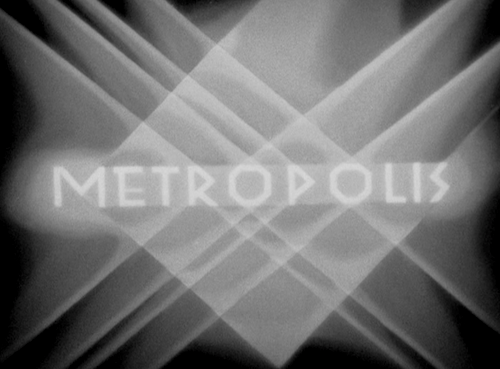
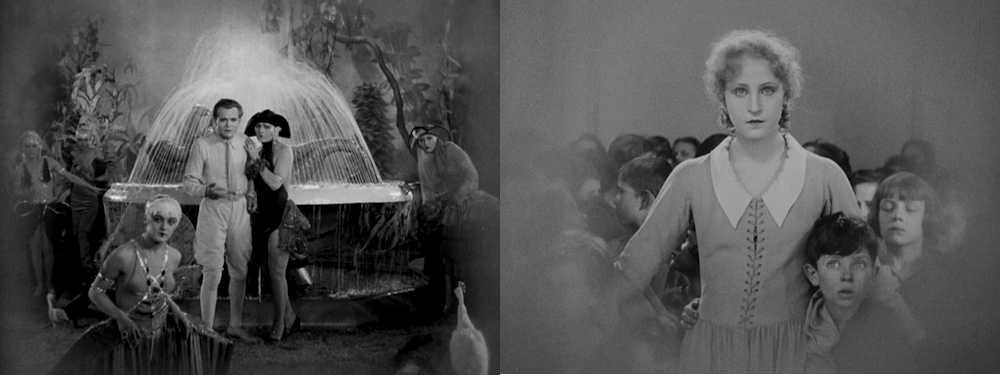

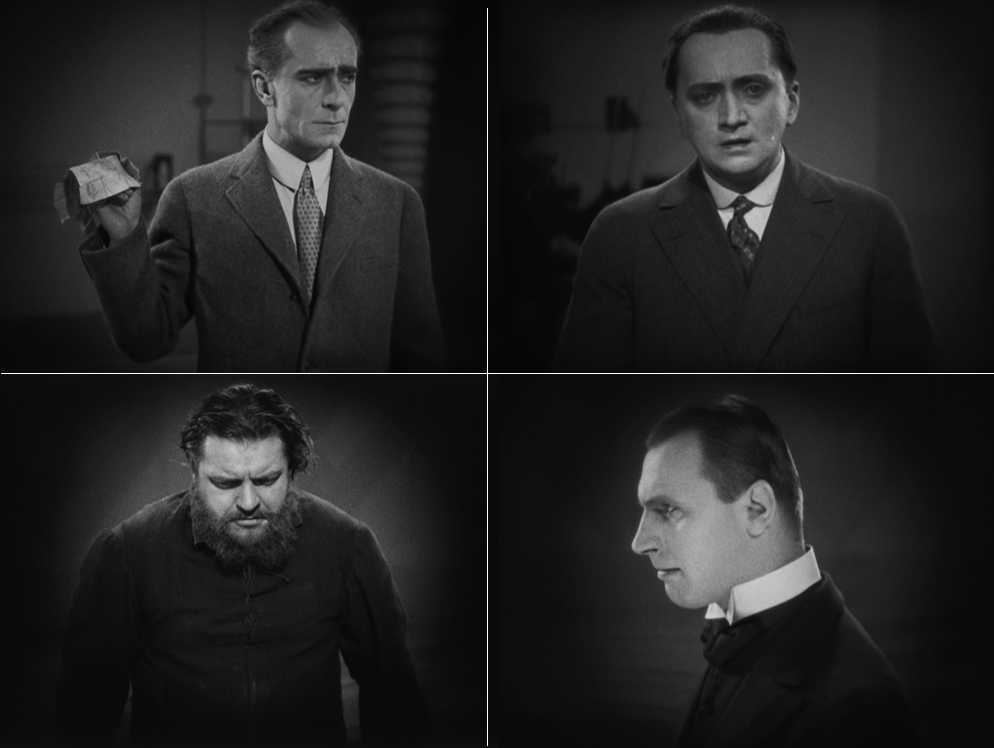
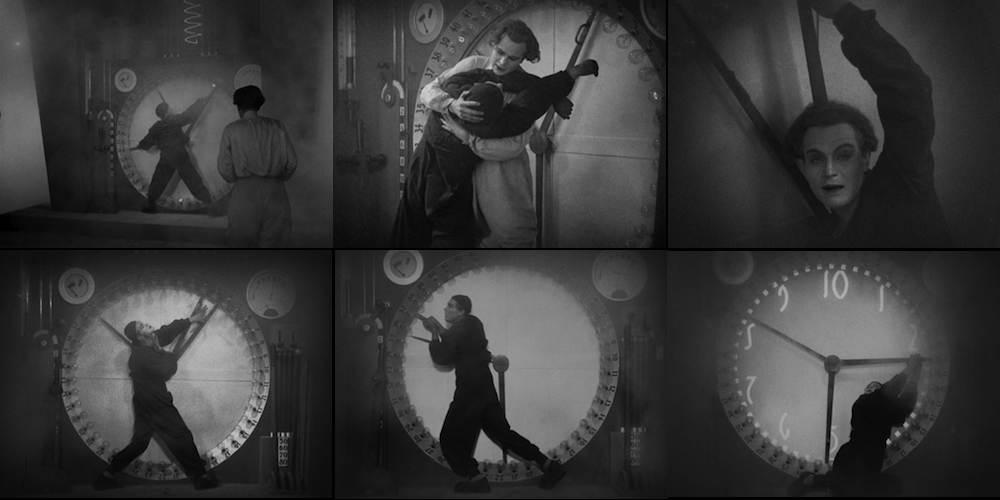

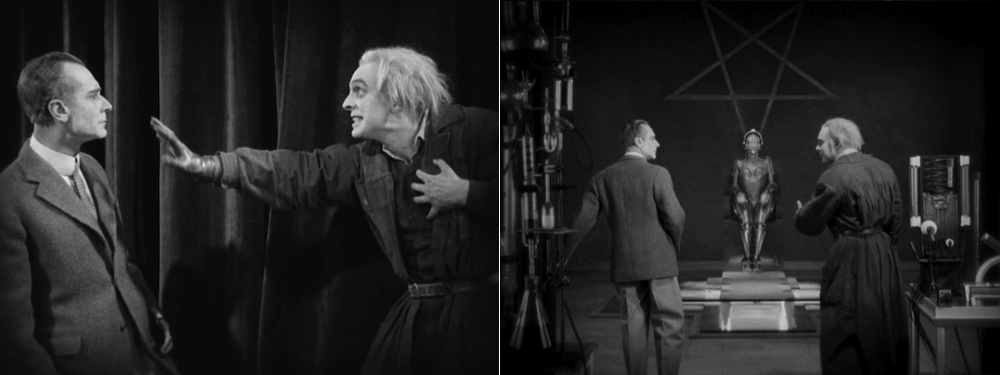







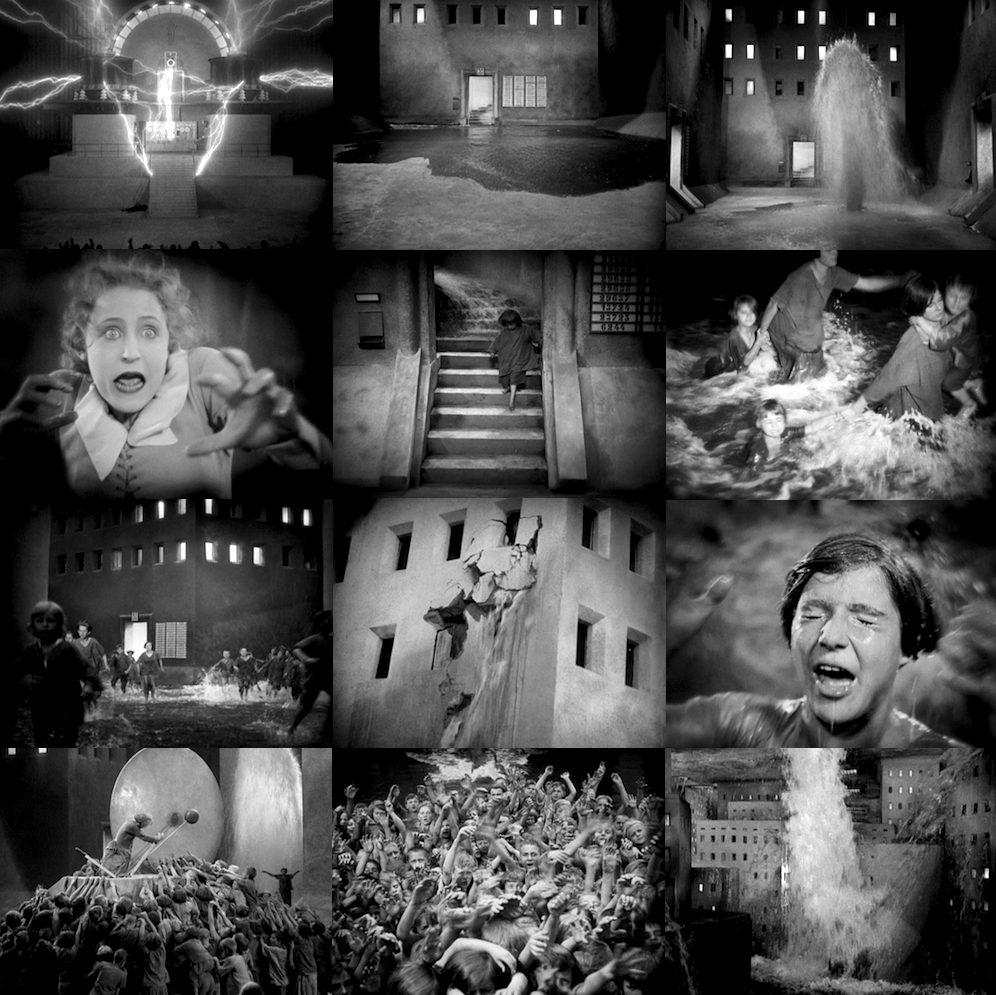

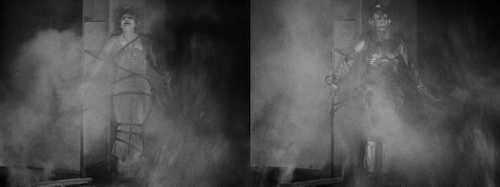
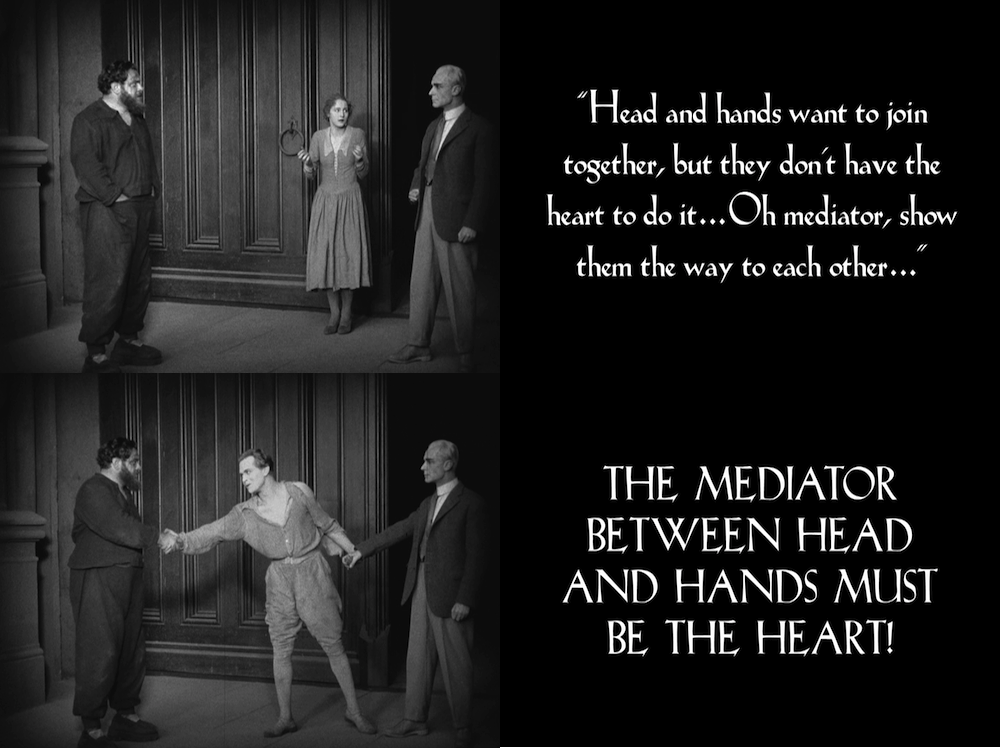
8 thoughts on “METROPOLIS (1927)”
My vague sense of this movie has been that the visuals are EXTREMELY memorable, and that I don't remember much else. There are A LOT of ergonomic problems with Freder's turn on the "clock machine."
There are a lot of problems with the machines: a machine that requires constant, high-stress interaction from a human to avoid exploding is probably not a good design. They're less "machines" and more like "fiendish death traps."
I forgot it was called…"the heart machine." I actually LIKE that sort of ridiculousness.
Pingback: Fritz Lang’s Metropolis Restored with a Soundtrack Featuring Freddie Mercury, Adam Ant & Pat Benatar - NWZ
Pingback: Fritz Lang’s Metropolis Restored with a Soundtrack Featuring Freddie Mercury, Adam Ant & Pat Benatar | Golden Gate Daily
Pingback: The Novel Form of "Metropolis": Review, Part 2 - Nyssa's Hobbit Hole
Pingback: Read the Original 32-Page Program for Fritz Lang’s Metropolis (1927) - Online Classes
I'm looking at Metropolis as part of my literature degree in a modernisms module. I just wanted to say how much I thoroughly enjoyed reading this review and it gave me much more pleasure than being conned into going to see the actual film by my lecturer. You've not only added clarity to a murkily plotted film but also added great contextual points and bought a smile to my face and helped me write some brilliant answers to go throw at the lecturer in my seminar. Cheers.